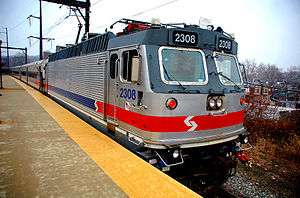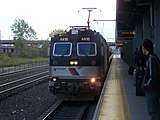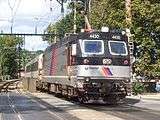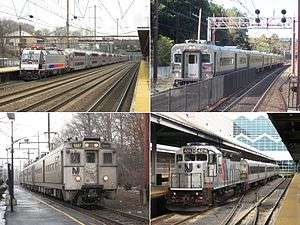ABB ALP-44
The ABB ALP-44 was an electric locomotive which was built by Asea Brown Boveri of Sweden between 1989 and 1997 for the New Jersey Transit and SEPTA railway lines.
| ALP44-O / ALP44-E / ALP44-M | |||||||||||||||||||
|---|---|---|---|---|---|---|---|---|---|---|---|---|---|---|---|---|---|---|---|
 SEPTA ALP-44M No. 2308, the last ALP-44 in regular service | |||||||||||||||||||
| |||||||||||||||||||
| |||||||||||||||||||
| |||||||||||||||||||
| |||||||||||||||||||
Service
New Jersey Transit
New Jersey Transit acquired 32 ALP-44s for use on its electric lines. The first fifteen, numbered 4400–4414 and designated ALP-44O (Original), were delivered in 1990 (prototypes 4400 and 4001 in late 1989). Five additional units, numbered 4415–4419 and designated ALP-44E (Extended), were delivered in 1995. The final 12 locomotives, numbered 4420–4431 and designated ALP-44M (Microprocessor), were delivered in 1996[2]:45 for the new Midtown Direct service.
NJT's ALP-44's were to be overhauled for a cost of $2 million during a two-year period by Philadelphia-based Interfleet Technology. A car builder had not yet been selected to carry out the overhaul.[3] However, as of June 2009, NJT has decided that it would be more efficient (economically and physically) to replace the ALP-44's rather than overhaul them, and has exercised an option of 9 additional ALP-46A's to enable the replacement to take place.[4]
As of late 2011, all NJ Transit ALP-44 O, E, and M locomotives have been retired. All units were retired with the delivery of the remaining ALP-46A locomotives, except Nos. 4405, 4407 and 4409, which were assigned to the Atlantic City Express Service (ACES); however, these remaining units were also placed into retirement with the cancellation of ACES service in early 2012. Unit Nos. 4402, 4403, 4408 and 4410 were leased by Amtrak for work train service through the Hudson River tunnels for a period of time during summer 2011, but have since been returned.
During 2012, the ALP-44's were prepared for storage in groups of five at a time. This work includes the removal of pantographs and having the cab windows covered with steel plating. These units were then moved to Port Morris Yard and the Lackawanna Cut-Off stub track for storage in Stanhope, New Jersey, where they are now stored today.[5]
SEPTA
SEPTA received a single ALP-44M unit, #2308, from ABB, which was part of a damage settlement for a lawsuit stemming from the late delivery of N5 cars for the Norristown High Speed Line.[6] It was replaced along with the AEM-7s with the ACS-64 in October 2018, with a farewell trip on December 1, 2018.[7][8][9]
After the farewell, 2308, as well as seven AEM-7's, were leased to NJ Transit to help alleviate a locomotive shortage due to positive train control installation on their locomotives. However, they were never used for New Jersey Transit and they have since returned to SEPTA in May of 2019. The AEM-7s and the ALP-44 are now used exclusively in SEPTA work service.
Specifications
The ALP-44 was based on the Rc6 model and designed specifically for New Jersey Transit as a variant of the EMD AEM-7 electric locomotive, used by Amtrak (before June 2016), MARC (before April 2017), and SEPTA (before November 2018). ALP-44 stands for American Locomotive Passenger 4-Axle 4.32 MW. The ALP-44 is powered by overhead lines through one of the locomotive's two pantographs and can produce up to 7000 hp (5.2 MW) with a top speeds of up to 125 mph (201 km/h). In commercial use however, both New Jersey Transit and SEPTA ALP-44s are cleared for speeds up to 100 mph (161 km/h).
ALP-44M
The ALP-44M is a variant of the original ALP-44 design. It included a microprocessor control for functions such as braking and the then new EPIC brake control stand. These locomotives were notorious for their faulty software, which frequently caused problems and kept them out of service for maintenance.
Gallery
 NJT ALP-44O #4408
NJT ALP-44O #4408 NJT ALP-44E #4416
NJT ALP-44E #4416 NJT ALP-44M #4430
NJT ALP-44M #4430 Retired NJT ALP-44s stored on the Lackawanna Cut-off
Retired NJT ALP-44s stored on the Lackawanna Cut-off
See also
References
- https://web.archive.org/web/20010218070341/http://hem.passagen.se/plf66/typer-exp/typer-export-alp44.html
- "Commuter Rail Fleet Strategy 2014-2020" (PDF). New Jersey Transit. 2014. Retrieved August 12, 2016.
- August 29 2008 Archived October 24, 2009, at the Wayback Machine
- NJT Press Release
- http://ns3010.rrpicturearchives.net/archivethumbs.aspx?id=78581%5B%5D
- Yough, Patrick J. (April 2013). "SEPTA at 30". Railfan & Railroad. 32 (4): 42.
- "Farewell to the SEPTA AEM-7 Locomotives". SEPTA. Retrieved December 1, 2018.
- Dan, McQuade (November 11, 2015). "SEPTA Is Buying 13 New Locomotives for $113 Million". Philadelphia Magazine. Retrieved December 6, 2017.
- SEPTA FLEET UPGRADES, September 5, 2018, retrieved September 5, 2018
External links
| Wikimedia Commons has media related to ABB ALP-44 locomotives. |
- New Jersey Transit
- SEPTA
- New Jersey Transit rail operations
- Unofficial NJT locomotive roster
